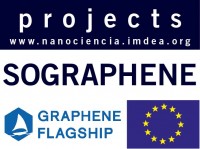SOGRAPH Tailoring Spin-Orbit Effects in Graphene for Spin-Orbitronic Applications
Prof. Rodolfo Miranda (coordinator), Prof. Julio Camarero and Dr. Paolo Perna (PI).
-
Funding :
FLAG ERA Graphene Flagship. PCIN-2015-126
-
Duration: 2015 - 2017
-
36 months
The development of all-graphene spintronic devices requires that, in addition to its passive capability to transmit spins over long distances, other active properties are incorporated to graphene. Recent advances by some of the partners have led to the generation of long range magnetic order and spin filtering in graphene by molecular functionalization as well as the introduction of giant spin-orbit coupling (SOC) in the electronic bands of graphene by intercalation of Pb.
The SOgraphene project incorporates these developments as the base for designing novel nanoarchitectures targeting the investigation of the role and the control of SOC in graphene as a source of large chiral exchange interaction, commonly known as Dzyaloshinskii–Moriya interaction (DMI), leading to stabilization and manipulation of magnetic skyrmions, and/or as efficient source of large pure spin current by Spin Hall Effect (SHE).
SOgraphene aims to i) create, ii) characterize, iii) image, and iv) test all-graphene spin-orbitronic systems/devices functional at room temperature (RT) by exploiting the advantages of combining ferromagnetic (FM) and/or non-magnetic (NM) heavy metals underneath of a graphene (gr) layer. In particular, the following stack sequences gr/Pb/Co/NM2 and gr/Pb/ insulating will be explored. Different issues will be addressed: a) induce large interfacial chiral interactions and skyrmions in perpendicular magnetic anisotropy (PMA) ultra-thin Co layers in proximity with Pb, b) induce SOC and SHE in graphene by the proximity of Pb; and c) the combined proximities of graphene with Pb and Co to imprint skyrmionic textures into graphene. For the three cases, the gate-tunability of graphene would, in addition, allow electric field control of such interface-induced effects. In view of practical applications, SOgraphene will open the way for the development of the next generation of low-power, faster and smaller spin-orbitronic devices in 21st century.
http://nanociencia.imdea.org/images/nanociencia/scientific_reports/Scientific-Report-2015.pdf#page=119




